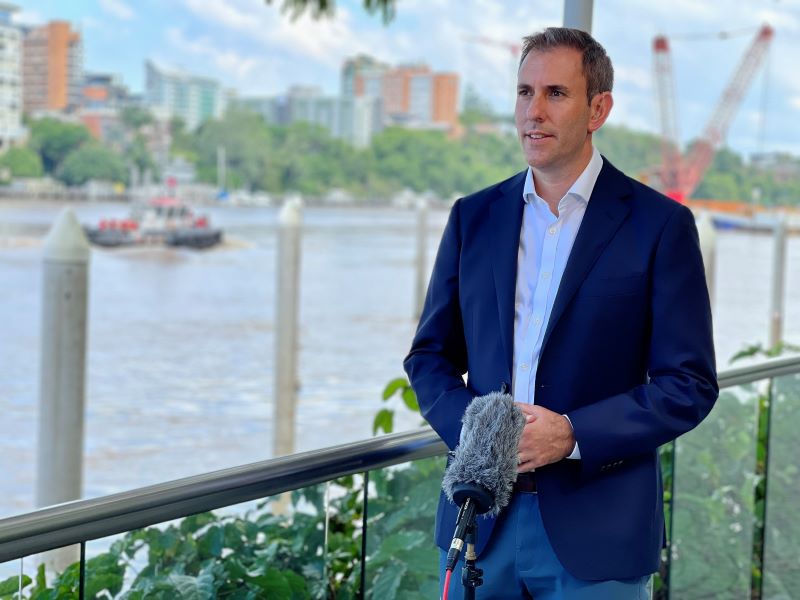Australia’s industrial policy must be “recast and modernised” to take advantage of the global energy transition, the Treasurer said on Thursday, while promising a new “uniquely Australian” plan that leverages more private capital amid bolder public investment overseas.
Dr Chalmers laid out a new approach to developing policy that maximises Australia’s comparative and competitive advantages through a focus on economic diversity, renewables and a greater role for the Productivity Commission.
He also unveiled new proposals to encourage more private investment in the ventures driving Australia’s energy transition, saying private capital will do the heavy lifting in the shift to net zero emissions.

The Albanese government is under pressure to respond to massive subsides for clean energy in the US through its Inflation Reduction Act (IRA), or risk losing local firms offshore and limiting Australia’s role in the global energy transition.
Analysts have predicted the IRA could end up offering around US$1.2 trillion in uncapped tax credits and other incentives over the next decade while pulling in even more through private investors.
“The availability of public and private capital is a really important issue but it’s not the only issue,” Dr Jim Chalmers said.
“… that means incentives like the type we’ve seen in the Inflation Reduction Act in the United States can be part of an answer but they’re not the whole answer.”
The Albanese government is still in the process of establishing a $15 billion National Reconstruction Fund that will invest up to $3 billion in renewables and low emissions technologies.
Experts say the government investment is needed but lacks a framework to get the most out of the money, while Australian electric vehicle charging company Tritium this week said the fund will be too late to save it from dire liquidity issues and a move overseas.
The Albanese government will also offer at least $2 billion in green hydrogen production credits, $4 billion in loans for critical minerals projects and a $20 billion fund for transmission infrastructure to try and capitalise on the energy transition.
More industrial policy announcements are expected later this year on the back of the government’s own $5.6 million analysis of global competition for clean energy industries.
Speaking at the Economic and Social Outlook Conference in Melbourne on Thursday, Dr Jim Chalmers said the government “will complement not copy the priorities and plans of other nations, not just do exactly the same kind of investment with the exact same subsidies”.
“We won’t realise Australia’s unique geographical, geological, geopolitical, intellectual and meteorological advantages by designing an Inflation Reduction Act Lite – looking only for big numbers but missing the bigger picture.
“Our plan will be ambitious, but uniquely Australian, focused on Australia’s strengths – on renewable energy, resources, our reputation as a trusted and reliable trading partner, on our people, and our knowledge.”
Unable to match the scale of subsidies in the US, the government will look to get more out of its investment through industrial and financial policy, the Treasurer said.
“We recognise the moment we’re in poses a different set and kind of economic and social challenges than the 1950s or the 1980s, so our approach to industry policy needs to be different too,” Dr Chalmers said.
“Like all shifts that involve big change and uncertainty, the private sector will do most of the heavy lifting – but existing market structures won’t always cut it – especially when we’re trying to create new markets and transform old ones.”
On Thursday, the Treasurer launched consultations on a Sustainable Finance Strategy he said will lead to better information on climate and sustainability, so investors and companies can better manage climate‑related risks and have more confidence in backing clean energy projects.
Dr Chalmers said national industrial policy is also being “recast and modernised” to grow local companies, skills, and technologies to give investors better targets. The focus is on industries that diversify the economy and make Australia more competitive in global markets, while being mindful of their impact on community and national security.
“Balancing up all these considerations successfully: competitiveness, distribution of opportunity, resilience and national security — all anchored to our climate and energy goals — is our new industry policy approach for net zero.”
“This is how we are approaching decisions about where active industry policy is best directed in a new way,” he said.
Decisions about net zero industry policy will be guided by five new principles, the Treasurer said:
- Whether Australia can be competitive in the industry, by leveraging and building up our comparative advantages
- Whether it contributes to an efficient and orderly pathway to net zero
- Whether it builds the capabilities and resilience of people and regions
- Whether it improves Australia’s national security and economic resilience and supports the strategic objectives of our global partners
- And whether it recognises the key role of the private sector and delivers genuine value for money for government
The principles have led to the government’s prioritisation of four key areas in the energy transition so far: refining and processing critical minerals; manufacturing of storage and generation technologies; green hydrogen and its derivatives; and “a future in green metals”.
“In priority areas like these, the appropriate role for Government is helping to make industries competitive for the long term, not just underwriting short term profits,” Dr Chalmers said.
The Treasurer said a more influential and “constructive” Productivity Commission operating under its first ever statement of expectations and new chair Danielle Wood will play a larger role in guiding Australia’s energy transition.
“We want more practical and relevant advice here as a priority ‑ so that we can secure the productive and prosperous transformation of our economy,” Dr Chalmers said.
Do you know more? Contact James Riley via Email.

